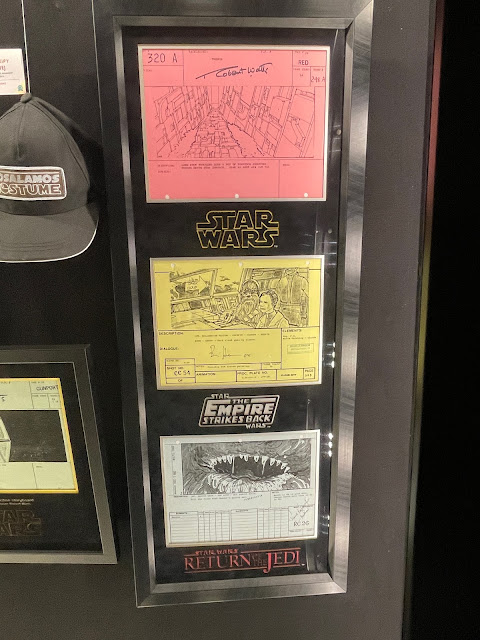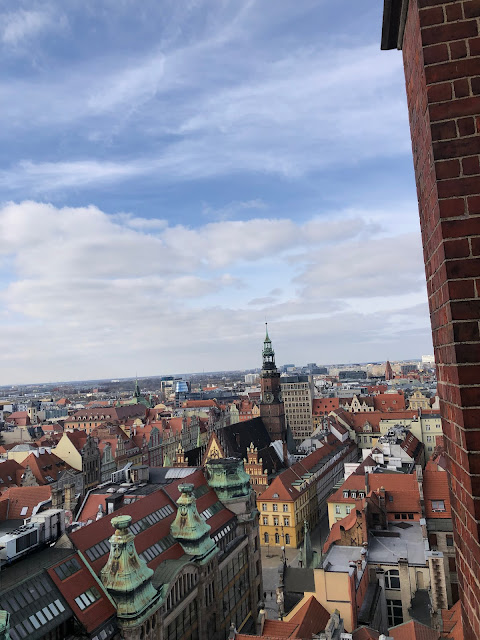Today was our day to explore Wrocław (pronounced Vrot-swaf), which is the largest city in Silesia (a region including some of southwest Poland, and small parts in Czech Republic and Germany) and the third largest city in Poland.
The river Oder runs through Wrocław, and the town intersects two old trade routes, the Via Regia (through the Holy Roman Empire) and the Amber Road (from the North and Baltic Seas to the Mediterranean).
It is believed the city was built in the 10th century and has been ruled by Poland (Dutchy 985-1038) and Kingdom 1954-1320), Bohemia (1038-1054), the Habsburgs of Austria (1348-1469 and 1500s), Hungary (1469-1490), Prussia (1740s) and Germany (1871-1945). The town was German speaking and part of Germany until after the war in 1945 when it was claimed by Poland.
The town was believed to be named after Duke Vratislav of Bohemia, but this has been disputed and current though is that it is named after another Vratislav (Wrocisław in Polish) who was likely a local Prince.
It has also been known by its German name of Breslau.
In 1982 the communist government of the Polish People's Republic implemented martial law in response to pressure from its political rivals, such as the Solidarity Movement and Orange Alternative, which were founded in Wrocław.
In 2005, a series of bronze dwarfs or gnomes has been installed around Wrocław in recemberance of the Orange Alternative. In 2019 there were 600 gnomes around the city, by our visit there were over 1000. Some of the gnomes are sponsored by interest groups, such as the Deaf-mute and blind dwarfs erected by Wrocław Without Barriers.
We started the day with a walk towards the Old Town Hall (Stary Ratusz) and Market Square (Rynek we Wrocławiu), passing a few interesting buildings on the way. Kris had also purchased a Wrocław gnomes app to located the gnomes. We found as many as we could - pictures at the end.
First interesting building was the District Court (Sądzie Okręgowym):
We then crossed over the City Moat (Fosa Miejska) into the start of old town.
Our first stop (well second, after Kris got a picture of the gnome at the Police Headquarters next to the District Court) was the National Forum of Music (Narodowe Forum Muzyki im. Witolda Lutosławskiego) located in Plac Wolności. The Square was also bordered by the City Museum (Muzeum Miejskie Wrocławia) which was closed, as well another gnome display, the Orchestra (Krasnale Muzycy (Orkiestra)) and the Church of St. Stanislaus, St. Wenceslas, and St. Dorothea (Kościół pw św. Stanisława, św. Doroty i św. Wacława)
 |
| Church of St. Stanislaus, St. Wenceslas, and St. Dorothea |
 |
| National Forum of Music |
 |
| Orpheus (Orfeusz) |
 |
| City Museum |
From there we headed towards the Old Town Hall, taking a few more photos as we went:
 |
| Krokodyl Scultpure |
Wrocław market square is one of the largest market squares in Europe and dates back from medieval times. It houses the Old City Hall, New City Hall, the Salt Market and St Elisabeth's Church.
Building of the Old Town Hall (Stary Ratusz) started in the 13th century and it was finished in the middle of the 16th century. The building is in Gothic style. It was damaged in World War II, a bomb crashed through the roof (but luckly didn't explode) and the hall was restored throughout the end of the 1900s.
 |
| Bear Fountain (Fontanna Niedźwiadek) added in 1904. It was lost in WWII and rebuilt in 1998. |
Some other buildings around the square:
 |
| Roof of Saint Elisabeth's Church (the green and red) |
 |
| The House of Seven Electors (Kamienica Pod Siedmioma Elektorami) |

Our next stop was the Bridge of Penitents (Mostek Pokutnic) at the Cathedral of Mary Magdalene (Katedra św. Marii Magdaleny).
This is a bridge that spans between the two towers of the cathedral at 45m above ground level, giving a great view of Wrocław. There are two legends surrounding the towers- the first is that the ghosts of young women who partied with men instead of tending to the house and children were forced to walk the bridge between the towers. The second is the tale of Tekla:
There were 243 steps up to the top of the tower, but the view was worth it!
 |
| Towers and the bridge |
 |
| Heading up |
 |
| Old Town Hall |
 |
| Gnomes on the bridge - Tekla i Martynka |
 |
| St Elisabeth Church |
 |
| Cathedral Island |
We ducked back to the main square to grab a quick lunch and then headed out towards Cathedral Island, stopping for a few more pics on the way:
 |
| Church Of St. Maciej |
 |
| Cathedral of St. Vincent and St. James, Wrocław |
 |
| Market Hall (Hala Targowa) |
 |
| Protest against Russia and Putin |
 |
| Wall of the Jewish Theological Seminary Breslau Synagogue |
It had been a long day, but Wrocław was pretty cool to explore.
Here's the selection of the 82 Wrocław gnomes we found:
 |
| Rejestruś (Registrar) |
 |
| Klub Kibiców Niepełnosprawnych (KKN) Supporters |
 |
| Rachciach - Whambam the Lock Cutter |
 |
| Tian Tian |
 |
| Profesor Miodek |
 |
| Karmelek (Caramel) |
 |
| Dialogomir |
 |
| Bankomatnik, Pinek i Chipus (ATMers - Pinek and Chipus) |
 |
| Drukarz Kacper (Printer Kacper) |
 |
| Słuponik Solny 2 (Sonly Pole 2) |
 |
| Piwosz z Psem (Beer man with Dog) |
 |
| Dzioopelka |
 |
| The Orchestra |
 |
| Gołębnik (Pigeoner) |
 |
| Wiesiek partnerski (Village Partner) |
 |
| Rafał Dutkiewicz (Former city major) |
 |
| Źyczliwek (Well Wisher) |
 |
| Wiking (Viking) |
 |
| W-Skers, Ślepak and Głuchak (Wheelchair, Blind One and Deaf One) |
 |
| Wodziarz (Waterman) |
 |
| Lionek |
 |
| Halabardnik (Halbard) |
 |
| Troszka and Adoratorek |
 |
| Franek Moczymordka (Franky the Drunkard) |
 |
| Złotek (Money man) |
 |
| Motorcyklista |
 |
| Klucznik (Key) |
 |
| Gwaruś (Miner) |
 |
| Janinek |
 |
| Wromeo i Julianka |
 |
| Latarnik (Lamp Lighter) |
 |
| Syzyfki (Sisyphuses) |
 |
| Capgeminiusz Programista (Programmer Capgeminiusz) |
 |
| Świdnicki Pole 2 |
 |
| Dziarus (Tattooman) |
 |
| Solidarność Walcząca (Fighting Solidarity) |
 |
| Świdnicki Pole 1 |
 |
| Ditek |
 |
| Bankier (Banker) |
 |
| Unicefek (Unicef) |
 |
| Giełduś (Broker) |
 |
| Podatkus Doradek (Tax Advisor) |
 |
| Akademiusz (Academic) |
 |
| Słuponik Solny 1 (Sonly Pole 1) |
 |
| Krasnalka demokracja (Democracy Dwarf) |
 |
| Wyrostek i Zadymek |
 |
| Konspirek (Conspirator) |
 |
| Lombardzik (Pawn Shop) |
 |
| Gladiatorek (Gladiator) |
 |
| Patrolek (Patroller) |
 |
| Leszko z Wroclawca (Leszko in Wroclaw) |
 |
| Radcuś (Couselor) |
 |
| Powerek |
 |
| Cukiernik (Confectioner) |
 |
| Helper |
 |
| Kolekcjoner (Collector) |
 |
| Renata Otolińska - Symbol of Student Oppression |
 |
| Zeccuś |
 |
| Gryfosław |
 |
| Tekla and Martynka |
 |
| Wypłacarek (Payers) |
 |
| Miłostróż - Guardian of Hearts and Feelings |
 |
| Turysta (Tourist) |
 |
| Zraszacs Wodny (Water Sprinkler) |
 |
| Bartonik |
 |
| Exchanger |
 |
| Suvenirek (Souvenir Vendor) |
 |
| Orator |
Unfortunately we missed Pappa Dwarf, the one that started the whole trend, but here's a pic from wikipedia of him:
Well, it actually started with graffiti of gnome-like people with orange hats (in recognition of the Orange Alternative), but this was the first of the gnomes.






























































































































































No comments:
Post a Comment